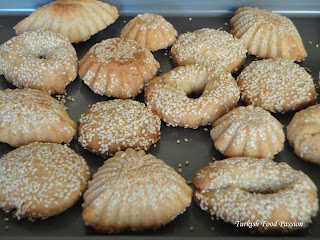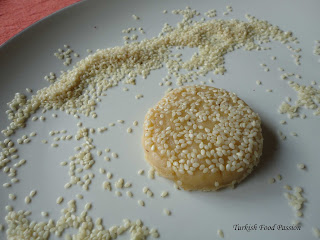

These delicious, spicy cookies are traditionally made in the Hatay province right after Ramadan, during Şeker Bayramı which translates to “Sugar Feast”. Almost every household in Hatay region makes these cookies in very large amounts which usually involves friends, relatives and neighbors getting together to make them. They are either baked at home or at the local bakery. Trays and trays of kömbe are sent to local, wood-fired bakeries during this season and the delicious smell just swifts through the air in the neighborhoods. Some bakeries stay open all night to keep up with baking these cookies. During the “Sugar Feast”, people visit each other and these cookies are served for the guests.
In other regions of Turkey, “kömbe” is the name for a pie/börek, so it can get confusing for people who are not from the Hatay region.
When I was growing up and eating these cookies during the holidays, I didn’t care much for them as they were abundant during this season. In the past 20 years that I have been here, I probably have eaten them only several times. Mainly when my mom would sneak them in my suitcase when returning to the U.S. after a visit or send them over with someone. Certainly, I have not had them the past 5-6 years at all. Recently, I saw them at a cousin’s Facebook page during the “Sugar Feast” and remembered them. Then, I craved them! I called my mom and got her recipe for it as I never attempted to make it before. I followed my mom’s recipe, except I added milk. I have never seen my mom put any milk in them, but some recipes call for it. Some people also stuff them with dates, or walnuts. I am not fond of the stuffed version. Traditionally, these cookies have special wooden molds for them. Since I do not have these molds, I used my mini tart shells to make the molds. I also made round cookies, flat cookies and even animal shapes for my kids.
Several years ago, I had a reader named George who had been to Antakya/Hatay and had purchased these molds and asked me for a recipe where he could use these molds. I had promised that I’d post it some time, but never got to it. I am not sure if I did lose that reader as I have not been actively posting on my blog, but if you are reading George, here is the recipe!
7 cups white flour
16 oz butter
1 whole nutmeg
1 small stick cinnamon
12 cloves
7-8 small pieces of mastic
½ tsp mahleb grounded
1 ½ cup sugar
¼ cup olive oil
1 cup milk
Lots of sesame seeds
Grind the nutmeg, cinnamon, cloves, mastic and mahleb. Combine them. The combination should amount to 1-2 tbsps depending on the desired strength of spices. Melt the butter. Add the sugar to the butter and mix until the sugar dissolves. Add the olive oil and milk and continue to mix. Add the spices and stir well.
Place the flour in a large bowl. Slowly add the butter, sugar, milk, olive oil and spice mixture. Mix until a dough forms.
Make walnut sized balls with the dough. Spread the sesame seeds in a flat plate.
For tartlet shell mold:
Take the ball and press one side onto the sesame plate.
Press into tartlet shell making sure the sesame part of the dough in the bottom.
Turn the tartlet shell upside down on the sesame place to coat the top of the cookie with sesame.
Place on a baking sheet.
For a flat cookie:
Take a ball and flatten with hands.
Cut with cookie cutter of your choice or a glass.
Coat both sides with sesame.
For circle shaped cookie:
Take a ball and start rolling back and forth to create a few inches long stick with the ball.
Roll the stick into the sesame plate.
Join the ends.
Place on the baking sheet.
Heat oven to 350 F° and bake for 35-40 minutes or until the cookies start to take a golden color.
Enjoy with hot Turkish tea.






























